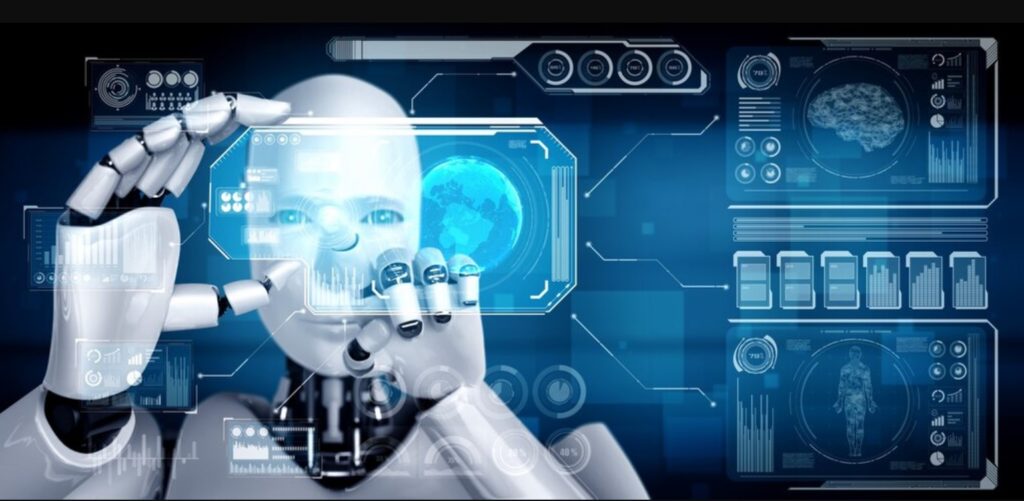Intelligent machines have been a topic of great interest in recent decades. By definition, intelligent machines are machines that can think and act like humans, often using artificial intelligence. Machine learning is a subset of artificial intelligence, and focuses on the development of computer programs that can access data and use it to learn for themselves.
In today’s world, intelligent machines and machine learning are becoming increasingly important. Many businesses rely on machine learning algorithms to provide better customer services, increase efficiency, and even predict customer behaviour. Machine learning has also been used in healthcare, with AI being used to diagnose diseases, prescribe treatments, and even detect cancer.

The history of machine learning can be traced back to the 1950s and the work of Alan Turing. Turing believed that machines could be taught to think and act like humans. In the decades since, machine learning has evolved, with new algorithms and techniques being developed to make intelligent machines more accurate and efficient.
This article, “Intelligent Machines: An Introduction to Machine Learning”, aims to provide an overview of intelligent machines and machine learning. It will discuss the fundamentals of machine learning, the various algorithms and techniques used, and the importance of intelligent machines and machine learning in today’s world. By the end of the article, readers should have a better understanding of the concepts, algorithms, and applications of machine learning.
Foundations of Machine Learning
Basic concepts of statistics and probability
Statistics and probability are the fundamental building blocks of machine learning. Statistics is the practice of collecting, organizing, analyzing and interpreting data. Probability is the study of how likely events are to occur. By understanding these concepts, machines can understand patterns, trends and correlations in data. This helps to form predictions, which can be used to create models and algorithms.
Types of machine learning (supervised, unsupervised, reinforcement)
Machine learning is divided into three main categories: supervised, unsupervised and reinforcement learning. Supervised learning is where the machine is given labeled data, which it uses to make predictions. Unsupervised learning is where the machine is given unlabeled data and must identify patterns and correlations without any guidance. Reinforcement learning is where the machine interacts with its environment and learns from its experiences.
Model selection and training
Once the type of machine learning is determined, the next step is to select the appropriate model for the task. Different models have different strengths and weaknesses, so it is important to select the model that is best suited for the task. After selecting a model, the machine must be trained on the data. This involves the machine using the data to learn patterns and correlations.
Data preprocessing and feature engineering
Before the machine can be trained, the data must be preprocessed. This involves cleaning the data, removing outliers and transforming the data into a format that is suitable for the model. Feature engineering is the process of creating new features from existing data. These features can be used to make the data more meaningful and to improve the performance of the model.

Applications of Machine Learning
Image and Speech Recognition:
Machine learning algorithms are used to recognize patterns in images or speech. They can be used to detect objects in images, recognize faces, or even read handwritten text. They can also be used to recognize spoken words, allowing for more natural interactions between humans and computers.
Natural Language Processing (NLP):
NLP is a field of artificial intelligence that focuses on understanding and interpreting natural language. Machine learning techniques are used to process and analyze written text, allowing computers to understand and interact with humans in a natural way. NLP can be used for a variety of tasks, such as sentiment analysis, text classification, and even language translation.

Fraud Detection:
Machine learning algorithms can be used to detect fraudulent transactions or activities. By recognizing patterns in data, algorithms can be used to identify suspicious activity and alert authorities. This type of system can be used to protect banks, retailers, and other businesses from fraudulent activities.
Recommender Systems:
Recommender systems are used to suggest products or services to customers based on their past purchases or activities. By analyzing customer data with machine learning algorithms, companies can create personalized recommendations for customers. This type of system can be used to increase customer engagement and sales.
Autonomous Vehicles:
Autonomous vehicles are vehicles that can drive themselves without human intervention. Machine learning algorithms are used to process data from sensors and cameras, allowing the vehicle to identify obstacles and navigate safely. Autonomous vehicles are becoming increasingly common, and they have the potential to revolutionize the way we travel.
Healthcare and Medical Diagnosis:
Machine learning algorithms can be used to diagnose medical conditions and provide personalized treatments. By analyzing patient data, algorithms can provide doctors with more accurate diagnoses and recommendations. This type of system can improve healthcare outcomes and reduce costs.
Business Analytics and Customer Segmentation:
Machine learning algorithms can be used to analyze customer data and create customer segments. By clustering customers based on their characteristics, companies can better understand their customer base and create more effective marketing strategies. This type of system can also be used to identify trends and predict customer behavior.
Challenges and Limitations of Machine Learning
Bias and Fairness:
Machine learning algorithms are vulnerable to bias, which can lead to inaccurate and unfair results. If the input data contains biased patterns, then the algorithm may learn and amplify those patterns, leading to an unfair outcome. It is important for data scientists to detect and mitigate this bias, in order to ensure fairness in the results.
Overfitting and Underfitting:
Overfitting occurs when a machine learning model performs too well on the training data, but fails to generalize to unseen data. This is usually caused by the model being too complex for the data, leading to the model fitting the noise in the data rather than the underlying patterns. Underfitting, on the other hand, occurs when a model has too little complexity, and is unable to capture the underlying patterns in the data. Both of these issues can lead to poor performance in unseen data.
Interpretability and Transparency:
Machine learning models are often opaque and difficult to interpret, making it difficult to understand why a model makes a certain prediction. This lack of interpretability limits the ability of data scientists to trust and understand the decisions being made by the model. It also makes it difficult to explain the decisions to stakeholders and regulators.
Data Quality and Privacy:
Poor data quality leads to poor performance in machine learning models. Data that is noisy or incomplete can lead to inaccurate predictions, or even erroneous results. Additionally, it is important to ensure that data is properly protected, as it can contain sensitive information about users.
Computation and Scalability:
Machine learning algorithms can be computationally intensive, requiring significant amounts of computing power and memory. In addition, these algorithms often require large amounts of data in order to produce accurate results. This can present a challenge when dealing with large datasets, as the computational cost can become prohibitive.
Human-Machine Collaboration:
Machine learning models can be powerful tools, but they are not a substitute for human intelligence. It is important to ensure that machine learning models are used in collaboration with humans, in order to leverage the strengths of both. This collaboration can ensure that the best decisions are made, and it can help to bridge the gap between human intuition and the power of machine learning.
Future of Intelligent Machines and Machine Learning
Current trends and emerging technologies:
The current trends in intelligent machines and machine learning are rapidly evolving. Technologies such as artificial intelligence, neural networks, and deep learning are becoming increasingly commonplace and have been used to solve complex problems in a wide variety of fields, such as healthcare, finance, and transportation. In addition, advances in robotics and automation are making it possible for machines to perform physical tasks that were once considered impossible. These technologies have the potential to revolutionize the way we live, work, and interact with each other.

Implications for society, economy, and workforce:
The implications of intelligent machines and machine learning on society, economy, and workforce are far-reaching. In the short-term, intelligent machines and machine learning technologies could create jobs and stimulate economic growth. In the long-term, these technologies could transform the way we work, with humans and machines working together to achieve greater productivity and efficiency. In addition, intelligent machines and machine learning could have a profound impact on the way people interact with each other, as well as on the way society is organized.
Ethical and policy considerations:
The ethical and policy implications of intelligent machines and machine learning are complex and far-reaching. For example, questions of privacy, security, and ownership arise when considering the use of intelligent machines and machine learning. In addition, issues of accountability, liability, and regulation must be taken into account when deploying these technologies. It is essential that ethical standards are established and adhered to, so that intelligent machines and machine learning are used responsibly and safely.
Research directions and opportunities:
The field of intelligent machines and machine learning is still in its infancy, and there is much to be learned and explored. There is a wide range of research opportunities in this field, including developing advanced algorithms, developing new applications, and exploring legal and ethical implications. As the field advances, there will be new opportunities for researchers to explore, develop, and innovate in this area.
Conclusion
It is evident that intelligent machines and machine learning are two essential aspects of modern computing. Through the foundations of machine learning, such as data collection and preprocessing, feature engineering, and model selection, as well as algorithms and techniques, such as supervised and unsupervised learning, neural networks, and deep learning, machines are now capable of making decisions and performing tasks that were previously thought impossible. Furthermore, machine learning has found a variety of applications in a multitude of fields, ranging from the business world to healthcare and beyond. With the growing popularity of machine learning, it is safe to say that intelligent machines are here to stay, and they will continue to revolutionize the way we interact with technology.
FAQ – Machine Learning
1. What is Machine Learning?
Machine Learning is a field of Artificial Intelligence (AI) that enables systems to learn from data and make predictions and decisions without being explicitly programmed. It is a subset of AI that focuses on the development of algorithms that can learn to make decisions on their own using data and patterns found in their environment.
2. What are the benefits of Machine Learning?
Machine Learning can help organizations become more efficient, accurate, and cost-effective. It can also help in enhancing customer experience, optimizing operations, and developing new products and services.
3. What are the types of Machine Learning?
There are three main types of Machine Learning: supervised learning, unsupervised learning, and reinforcement learning. Supervised learning requires labeled data, unsupervised learning does not, and reinforcement learning is based on rewards and punishments.
4. What is supervised learning?
Supervised learning is a type of Machine Learning the the algorithm is trained with labeled data. The data is labeled with the known output, and the algorithm is trained to predict the labels for new data.
5. What is unsupervised learning?
Unsupervised learning is a type of Machine Learning where the algorithm is trained with unlabeled data. The algorithm is trained to identify patterns and relationships in the data without any external guidance.
6. What is reinforcement learning?
Reinforcement learning is a type of Machine Learning where the algorithm is trained with rewards and punishments. The algorithm is trained to take the best action in a given situation based on the rewards and punishments it receives.
7. What is deep learning?
Deep learning is a type of Machine Learning that uses multiple layers of neurons to solve complex problems. Deep learning algorithms are able to learn from large amounts of data and can be used for tasks such as image recognition, natural language processing, and autonomous driving.
8. What is the difference between Machine Learning and Artificial Intelligence?
Machine Learning is a subset of Artificial Intelligence (AI) that focuses on the development of algorithms that can learn to make decisions on their own using data and patterns found in their environment. AI, on the other hand, is a broader concept that includes Machine Learning and other technologies such as natural language processing.
9. What are the applications of Machine Learning?
Machine Learning can be used for a variety of applications such as predictive analytics, fraud detection, customer segmentation, image recognition, natural language processing, and autonomous driving.
10. What is the role of Machine Learning in the future?
Machine Learning is set to play an increasingly important role in the future as more and more organizations are turning to it to become more efficient and cost-effective. It can also help in enhancing customer experience, optimizing operations, and developing new products and services.
